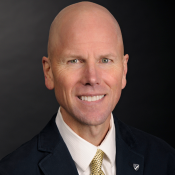COVID-19 has gutted businesses large and small, and damaged the psyche of the American workforce.
The pandemic has made them more reflective of who they are and what they’re getting from their employers, said an Arizona State University professor, who believes business leaders need to be more inclusive and empower their workers in the New Year.
And he has a model that can help motivate employee job satisfaction, performance and intent to stay.
Christopher Neck, an associate professor at the W. P. Carey School of Business, said too many businesses rely on command and control rather than motivation and self-guidance. He said the pandemic could be a learning opportunity for employers if they want to improve their organizations.
ASU News spoke to Neck about this new model and effective leadership.
Question: Are you able to give a brief summation of what you believe COVID-19 has done to the American workforce in terms of reflection and what they want from their employers?
Answer: COVID-19 has fundamentally disrupted the workplace — you can draw a bright line between before when the pandemic struck and now. This disruption comes from two forces. First, the pandemic has caused people to reevaluate what they want from their lives and — in turn — from their jobs. Many workers have asked themselves if their jobs should drive their lives or if their jobs should serve the way they live.
The pandemic also broke workers' old habits, day-to-day routines that kept them bound to a certain workplace or way of doing things. Habits hold great power, and once you break these habits, as with remote work or having to adopt new safety precautions, people start looking at old behaviors in different ways and start forming new routines.
Employers need to recognize that these forces also mean that workers will look for both guidance in what path to take next and support in navigating these changes. We found that leader communication has a tremendous power to help employees work through these changes and to empower people to take greater control over charting their own lives — their self-leadership.
Q: In your paper “Speaking to the self: How motivating language links with self-leadership,” you state that there is a lack of leadership and motivating language in regards to today’s workforce. Can you give us an example of what you mean?
A: Yes, many organizations have required their employees work in unsafe conditions during the COVID-19 pandemic. You can see the response to this poor leadership in the great resignation. Leadership has to mean more than just giving orders — it has to include looking out for those who follow you. Unfortunately, too many organizations focus on command and control. Using motivating language means more than just communication — it also means that someone thinks about a follower’s emotions, personal values and well-being.
What has happened during the pandemic is that organizations had to make massive changes and they did not do a good job in communicating how the people fit into these changes. Even ignoring the health issues, people became confused, stressed and distrustful of the changes taking place and the lack of explanation they received about these changes. Looking at the health issues, people died.
Finally, this was a time when organizations needed to develop workers’ self-leadership — their self-reliance and autonomy. Most organizations failed to do so and simply cast people to their own devices. Self-leadership is a personal action, but it needs a nurturing environment where people can feel trust in order to flourish.
Q: You say you have a model that improves both leadership and motivating employees. Can you give us a snapshot of what that looks like?
A: I am happy to. My co-authors and I looked at how leader communication helps a worker improve their self-leadership. Self-leadership is someone’s ability to set their own work goals and how well they can create a mindset to reach these goals. While self-leadership comes from inside a person, we found that better leader communication can increase this ability by a third. We also found in this study and previous work that self-leadership substantially increases a worker’s performance, job satisfaction and reduces their turnover. With the pandemic, of course, keeping good workers has become a priority for many companies.
Our work shows that when leaders engage in a positive communication strategy captured by motivating language, they will see increased self-leadership and substantial improvements in worker outcomes. We found that when a leader uses strong motivating language, followers perform about 15% better, have over 40% higher job satisfaction and feel about 50% more likely to stay in their jobs. Of note, their trust and perceptions of leader effectiveness increased by 70% or higher.
To best use such communication, leaders and organizations need to engage in three types of communication. First, they need to use direction-giving language (the hands) to help employees understand specific tasks associated with their job, to convey transparency and reduce ambiguity. This type of communication has become more necessary as companies have had to adopt new ways of operating during the pandemic. Workers may need directions on health precautions, customers angry about these health precautions or how to deal with supply chain disruptions. Employees also need emotional support through empathetic language (the heart) to feel understood, appreciated and validated. These communications help reduce stress during bad times and promote positive emotions after good things happen. Right now, workers need such support for dealing with the disruptions caused by work changes and — unfortunately too often — for personal losses they may have experienced from COVID-19. Finally, leaders use meaning-making language (the spirit) to align a worker’s individual goals and values to an organization’s culture and mission. Today, workers may need guidance on new cultural rules that may have emerged from the pandemic. In addition, meaning-making language can help an employee understand how their workplace fits into the bigger picture of their life — why the job is more than just a paycheck. By using all three forms of communication, leaders and organizations give workers what they need to deal with these troubled times.
Q: Are there any companies today who you feel are emulating this model well, and what’s been their outcomes?
A: Yes, though one example is a country rather than a company. Recently, Dr. Suze Wilson at Massey University examined how New Zealand was able to effectively cope with COVID-19 and become one of the first nations to get a grip on the pandemic. She found that a crucial ingredient was the prime minister’s (Jacinda Adern) use of motivating language with the public and government officials. She used direction-giving language to let people know the safety steps they should take, empathetic language to provide emotional support for the difficult times ahead and meaning-making language to pull New Zealanders together to act as a united front to navigate the pandemic. As a result, New Zealand has nearly the best COVID-19 situation in the world, with only minimal restrictions on daily life.
As for a company, Cytokinetics’ (a pioneering pharmaceutical development company) top leadership has effectively used motivating language in many areas. One of the most dramatic cases came a few years ago, when one of their leading drugs didn’t make it through a testing trial. At the time, this setback could have devastated the company. The CEO talked to his people, talked frankly about how the results must be stressful and disappointing for everyone (empathetic language), reminded everyone that the setback would not change the company’s commitment to pursuing drug treatments for important but often neglected diseases (meaning-making), and then transparently updated his employees on the company’s next steps, how they could move resources around to new drug testing and everyone’s role in this next step (direction-giving language). As a result of his talk, everyone there stayed with the company — an accomplishment in itself since they were located in the Silicon Valley. People felt a renewed sense of purpose, and Cytokinetics has since gone on to achieve breakthroughs in drug development and financial success.
Q: What advice do you have for companies as they look to the workplace after COVID-19?
A: It’s always difficult to make predictions — the last few years have shown us how radically the world can change without warning. But these changes should teach leaders the importance of developing organizational and worker capabilities that allow for greater resilience in the face of unexpected changes. We know that organizations do better in such situations when they have people who can act on their own initiative and have the internal resources to deal with disruptions. By fostering employees’ self-leadership, an organization will develop such workers.
We also know that quality communication — from all levels of an organization — gives companies a powerful edge in the marketplace. When leaders use motivating language, they provide the communications employees need to thrive in a workplace and see it as a place where they want to give their best. By using motivating language as a communication framework, leaders can have a handy reference to make sure they have communicated the right things to their followers.
While establishing these fundamentals won’t guarantee a future without problems, it will ensure that the company can deal with any problems in the best way possible. Beyond just dealing with problems, looking to such methods will give organizations the tools they need to make the changes necessary for adapting to whatever the workplace looks like after the pandemic has passed.
Top photo courtesy of Pixabay
More Business and entrepreneurship

When self-leadership turns self-destructive
Self-leadership is a relatively new practice of understanding who you are and developing strategies to motivate yourself to achieve a desired goal. When applied correctly, it can help a leader…

New ASU business graduate degrees meet emerging market needs
Following the successful launch of the nation's first graduate program in artificial intelligence in business, the W. P. Carey School of Business at Arizona State University is adding to and…

3 ways to start sounding like an executive
Story by May BuschEditor's note: This story was featured in the winter 2025 issue of ASU Thrive.Whether you love meetings or hate them, they are golden opportunities to demonstrate your executive…

